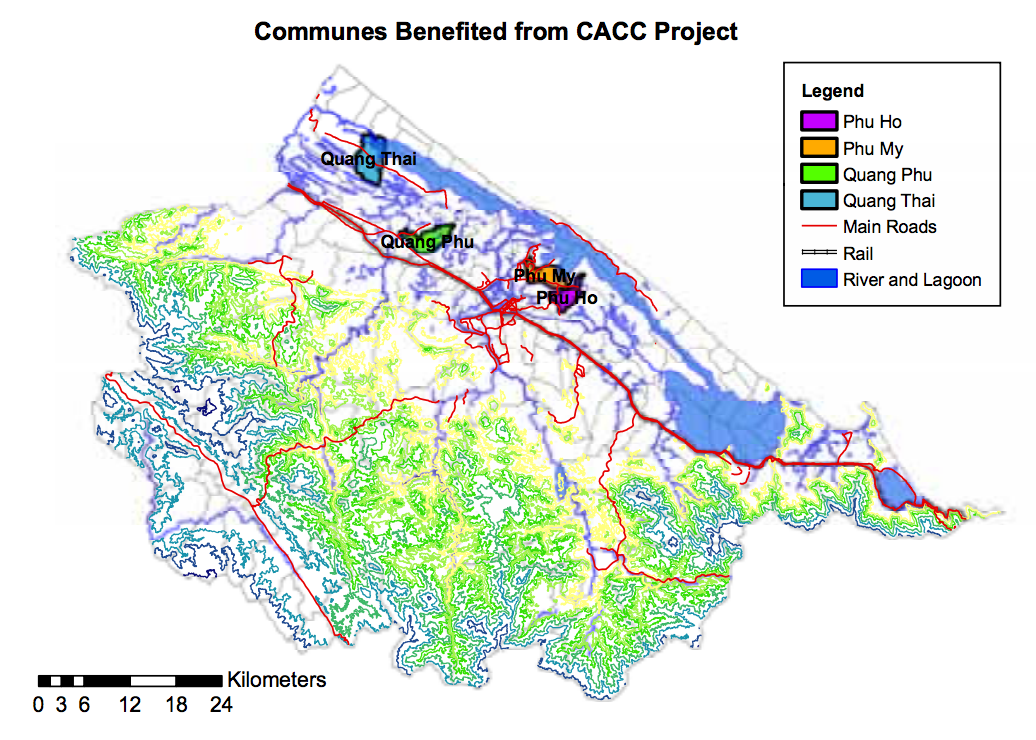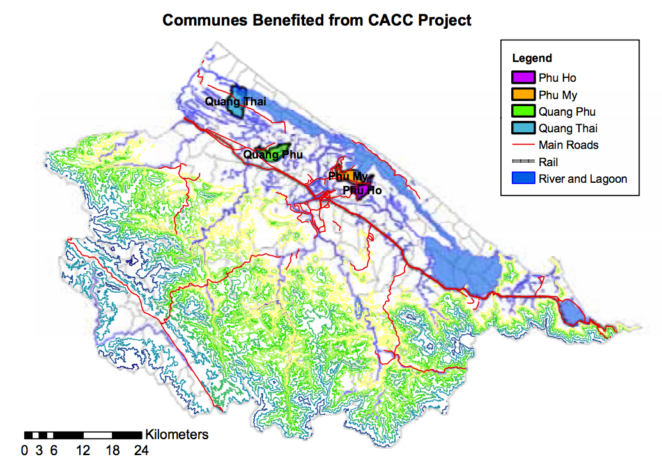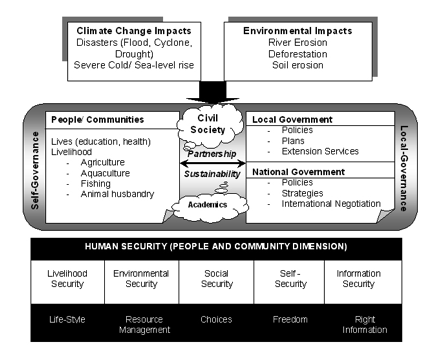Case-study /
Community-Based Adaptation to Climate Change in Vietnam (CACC)


Location of communes who benefited from the CACC Project
Adaptation context
Following the 1999 flood, many international donors started assisting the Vietnam government to create a partnering strategy and prepare disaster-resistant investment projects for the sustainable development of Central Vietnam through a Natural Disaster Mitigation Partnership. Most of the internal assistance was ad-hoc, which ended over a period of two to three years from 1999. The key need was to raise awareness at different levels, from policy makers to communities, on the increasing risk of climate change. Since climate change mitigation is beyond the control of the local governments and local communities, the immediate need was to look at the climate change adaptation in a more pro-active form, and to take actions at local level.
Project overview
One significant initiative was that of CECI (Canadian Centre for International Studies and Cooperation), a Canadian NGO, and was funded by CIDA (Canadian International Development Agency), under Canada Climate Change Development Fund (CECI 2004). The CACC (Community-based Adaptation to Climate Change) project was a three-year joint effort.
The purpose of the project was to ‘strengthen capacity to plan and implement community-based anticipatory adaptation strategies through disaster preparedness and integration of risk reduction and mitigation into local development planning’.
The project was implemented in partnership with the People’s Committees of the province and districts as implementing partners. The Province of Thua Thien Hue is in the central region, one of the most disaster-prone areas of Vietnam. At the level of the Vietnamese government, the project comes under the general framework of the NDMP, which works to develop mechanisms to co-ordinate international development assistance for disaster mitigation and promote information exchange in the communities. The project aimed to increase awareness at the national and provincial levels regarding viable options for community-based adaptation to climate change as a contribution to programme and policy development in the sector of disaster mitigation and climate change adaptation.
Methodology
Three major steps were adopted in the project:
Step I Assessment: producing a scenario
Step II Planning: produce a plan
Step III Implementation: conducting actions as sub-projects.
During the assessment step, the key focus was the hazard, vulnerability, and capacity assessments. These were done through historic profiling, mapping, timeline, ranking, focus group discussion, interviews, and questionnaire survey. The purpose was to identify issues and priorities through participatory discussion.
In the planning step, the main focus was participatory planning. Before planning, structured training programmes were conducted on climate change issues, CBDRM (community-based disaster risk management), building code improvements to cope with flood and cyclone, agriculture improvement, and aquaculture improvement. The target groups of these training programmes were leaders of the mass organizations, commune and district government officers, and selected community members. Two types of plans were formulated. One was safer village plan, which outlined specific measures to ensure the safety of the people and infrastructure of the community. The other plan was safer production plan, which was aimed to secure livelihoods, targeting agriculture, aquaculture, and animal husbandry.
In the implementation step, selected sub-projects were implemented. Some of the examples included construction of inter-commune roads, construction of multi-purpose school as emergency shelter, construction of sanitary latrine, safe drinking water provision, provision of alternate crops and alternate species of shrimps and fishes, provision of relief and rescue equipments, provision of early warning equipments, and conducting of educational programmes in the schools for the children.
The characteristic of the sub-project implementation was the co-financing from the local government (commune-level) and individual funding from the beneficiaries. This process was able to create a strong ownership for the local community, and thus ensured the sustainability at grassroots level. Since the safer village plans and safer production plans were developed based on the close consultation with local governments, the implementation in the longer term was ensured through incorporating the plans in the local development activities.
Adaptation options

Climate change adaptation model
Conclusion
As evidenced from the above description of the project, as well as climate and disaster issues of Vietnam, climate change adaptation is required at local level to reach the wider part of the communities. The worst sufferers of the climate change impacts are the communities and people in the rural areas. In most parts of Asia, rural livelihoods depend on agriculture. Vietnam is no exception. Thus, to reduce the climate change impact or to adapt with it, the first and foremost is livelihood security.
The CACC project of CECI demonstrates a unique way of vulnerability reduction through enhancing capacities of local people and communities. This can be considered as people and community dimension of human security, which should include livelihood security, environmental security, social security, self-security, and information security. This concept is nicely demonstrated through different forms of project activities. Livelihood security is the first and the foremost priority, where improvement of life-style is desired through income generation in different options: agriculture, aquaculture, fishing, animal husbandry, etc. Environmental security is the second dimension, and is found to be important in many rural areas (including the project site of Central Vietnam), where natural resource management by the community is the key issue. Social security is the third dimension, which ensures different social benefits to the people, and enhances people’s choice for social services like health, education, etc. Self-security is the fourth dimension in which people and communities are engaged in self-help and co-operation, therefore increasing their degree of freedom. Social security and self-security are closely related to each other. The fifth dimension is the information security, in which right to information to people and community is of extreme importance to take the right decision and action. Needless to say, there are other dimensions of human security; however, these five dimensions are strongly focused in the project activities.
Climate change adaptation should be looked upon as community development process, through multi-stakeholder partnership. The major challenge of the community-based climate change adaptation is sustainability and up-scaling of activities. While it is necessary to sustain the efforts in long-term, it is also required to disseminate the pilot intervention experiences to wider places. The community-based climate change approaches are getting recognition as one of the important climate change impact reduction measures. To understand the ground realities and strengthen the people–government partnership, more demonstration projects are required to be implemented in the field. Continued efforts at different levels will help to enhance human security through environment and disaster management.
Contact
NGUYEN, Thi Oanh, Director, CECI-Vietnam
Funding Organisation
CIDA (Canadian International Development Agency)
